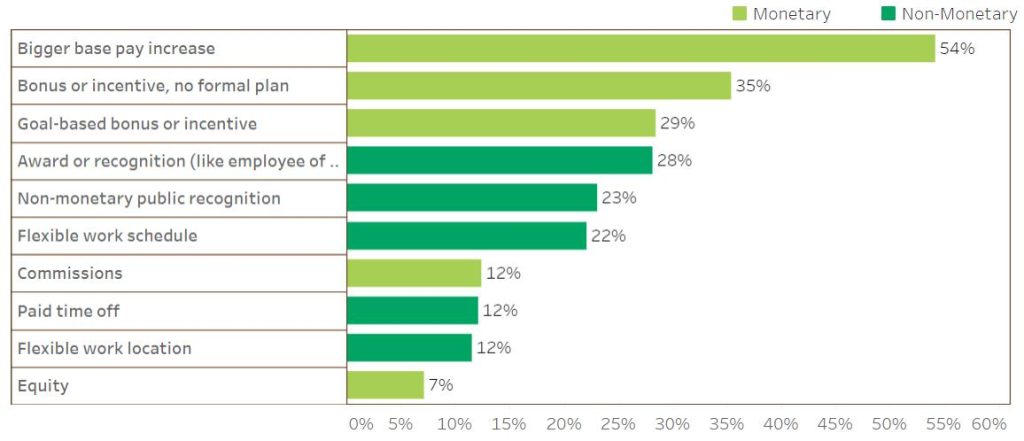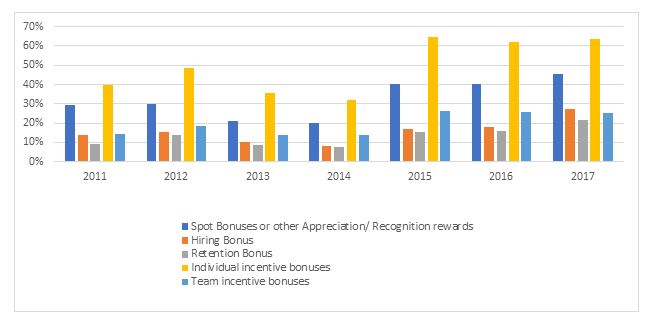When it comes to evolving performance management and pay for performance, it has definitely been a long haul. For the past few years, performance has been on the collective brain of HR and compensation professionals. At every conference over the past few years, the performance sessions have had standing room only. It seemed that large and small companies alike were trying many different methods often with the same realization: it’s just not working.
Performance practices are falling short
From my perspective, performance management gets a “Needs Improvement” rating. If the intention of performance evaluation is to improve performance and motivate employees to do better, the actual practice is falling short of the goal. Here are a few reasons why:
- They can be scary – Performance reviews cause the fight or flight response in employees, which doesn’t leave them open to a constructive conversation about improvement and aligning behavior with the company’s broader goals.
- They are time intensive – In a study designed to review their performance evaluation practices, Deloitte tallied up all the hours spent on performance management, arriving a staggering two million hours
- They look in the rearview mirror – Performance reviews typically have a backward-looking orientation, evaluating actions that occurred over the last year. Most organizations today move so fast that if the employee hasn’t changed a problematic behavior by the time of the review, they’ve likely to have been shown the door.
So, how can we improve the standard approach to performance evaluations? Companies should look for ways to change the nature of the conversation and train managers to have more informal, frequent coaching conversations and interactions. Research shows 42% of millennials want feedback every week, which can sound daunting when we’re thinking about performance in the old way. But more casual, tweet-length comments, in real-time, can do much more to positively impact future performance than the staid approach of the annual review.
At the 2017 WorkHuman Conference, Vicki Williams from NBCUniversal urged HR professionals to help managers become courageous enough to give feedback in the moment. There are a number of innovative technologies available to foster pulse-type performance feedback or even 360 performance feedback and recognition which can guide more productive conversations between managers and employees.
How do we measure performance better?
We’ve come a long way from “rank and yank” performance management. For example, most companies no longer force managers to tell great employees that they’re only okay, simply because we have an artificial allotment of “stellar” ratings to award. Measurement is perhaps the area of performance evaluation that has seen the greatest amount of experimentation. Here are a few examples:
- Some companies have dropped the ratings as well as the rankings. Instead, they coach their managers to focus on performance conversations, helping employees do their best to accomplish objectives.
- By contrast, other employers have abandoned the ratings, but behind the scenes group employees into performance buckets that look and feel like ratings without transparency.
- And some companies have kept their ratings, but streamline the review process to focus more on frequent coaching conversations.
The basis for ratings has also evolved over time, from MBOs to KPIs, SMART goals to OKRs. Whether cascading or not, the emphasis on both alignment and visibility from individuals to organizational objectives has remained an important focus. In agile organizations, cascading goals may take too long to develop, but priorities should still be clear and results-focused, leading to better performance conversations.
On a 2017 WorkHuman Conference panel discussion, Rahul Varma from Accenture spoke about their move from inhuman performance management to performance feedback that uses technology to enable highly personalized talent actions. While technology is enabling better options in performance management, the practice is continuing to evolve.
At the same conference, Josh Bersin said performance management is inherently broken because managers are ineffective; they should be trained to listen, coach and provide feedback more often. He urged employers to move toward continuous performance management that recognizes the networked, team-based nature of current organizations.
How do we connect performance with pay?
Perhaps the trickiest part about the continuing evolution of performance management is whether and how to connect performance with pay. Performance was the number one reason for giving increases according to PayScale’s 2017 Compensation Best Practices Report. High-performers want to believe they are paid more than typical employees; it is part of how they experience value and fairness in pay. However, paying for performance doesn’t necessarily mean giving big raises. There are many ways that organizations can reward and recognize performance, including monetary and non-monetary means.
How Organizations Reward and Recognize High-Performing Employees
 With so many ways to acknowledge performance, it’s surprising that 11% of organizations don’t reward performance in any way. On the flip side, that also means 89% of organizations reward or recognize performance in some way. The reality of paying for performance is that it’s getting harder to really differentiate pay for high-performing employees with large raises because compensation budgets are often constrained.
With so many ways to acknowledge performance, it’s surprising that 11% of organizations don’t reward performance in any way. On the flip side, that also means 89% of organizations reward or recognize performance in some way. The reality of paying for performance is that it’s getting harder to really differentiate pay for high-performing employees with large raises because compensation budgets are often constrained.
 According to the report, more than 30% of organizations have budgeted a 3% raise; more than 25% gave an average raise of just 3%, and 8% of organizations gave a highest raise of 3%. Ultimately, if an employer is only able to differentiate pay for the highest performers from average performers by a percentage point or two, it may be time to consider other ways to differentiate pay. The research also shows the prevalence of giving bonuses – another compensation method to recognize performance – increased in the past few years.
According to the report, more than 30% of organizations have budgeted a 3% raise; more than 25% gave an average raise of just 3%, and 8% of organizations gave a highest raise of 3%. Ultimately, if an employer is only able to differentiate pay for the highest performers from average performers by a percentage point or two, it may be time to consider other ways to differentiate pay. The research also shows the prevalence of giving bonuses – another compensation method to recognize performance – increased in the past few years.
Type of Bonus, 2011-2017

Assuming a market-based pay practice where jobs are set competitively and fairly for the relative talent market, moving performance-based pay to the variable pay arena makes sense in many cases. This approach offers more flexibility to reward a company’s highest performers. It also makes it easier to award team incentives, if the organization is oriented around team objectives and collaborative efforts. Perhaps most importantly, bonuses and incentives should be tied to the speed of business.
PayScale’s research also found that 40% of organizations paid out bonuses or incentives more than once per year. So, if an organization works on project cycles, managers may consider rewarding bonuses on the project timeline. Or if it works on quarterly cycles, pay incentives could be paid out quarterly.
Align to culture, business objectives
Ultimately, the way an employer acknowledges performance should be anchored in the culture of the organization and should be aligned to the broader business objectives.
History shows us that conversations about performance are not always effective opportunities to talk about pay. However, every conversation about pay is a good opportunity for a manager or HR professional to talk about performance, engagement, development goals, and what motivates employees to do their best work.
As large and small organizations continue to iterate and experiment in the revolution of performance-based pay and rewards, I expect we’ll see fewer annual performance reviews in exchange for more real-time discussions about performance and open dialogues about how pay can reward behavior.
